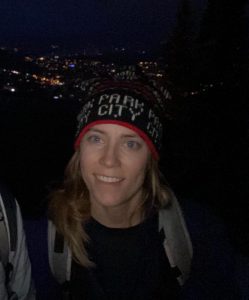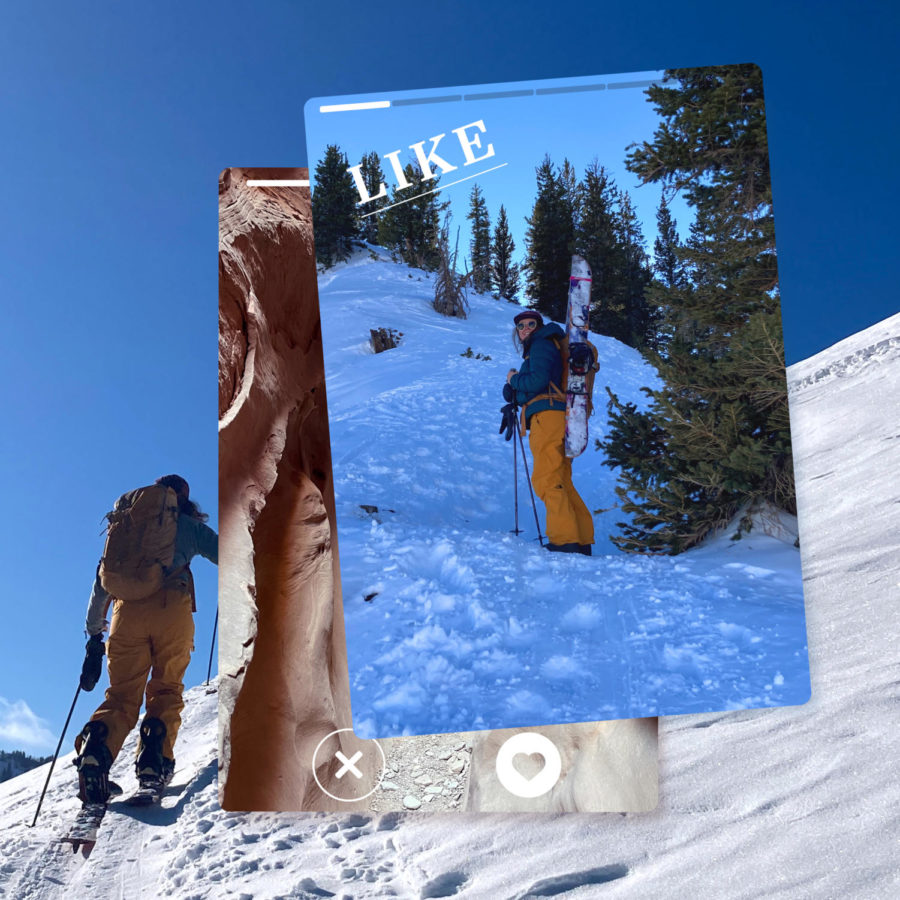Thoreau Lurks Behind Cute Girls in Canyons: Wilderness as Sexual Currency on Tinder
“I have a soft spot for cute girls in canyons,” I write to my new match on Tinder. Her first photo in a series of eight shows her grinning between the narrow walls of a slot canyon. Of the rest, three feature her in some kind of wilderness setting, looking confident in the foreground with the fuzzy backdrop of red rock or the Great Salt Lake behind her. Most of the people I have matched with on this dating app have at least an equivalent number of photos featuring wilderness in the collection they have chosen with care and intention to showcase their personality and, presumably, sex appeal. I have done the same. In my first photo, I am sitting in a kayak on a wide river, the Rio Grande, wearing a floppy hat and grinning, like this woman I have just matched with. In others, I’m standing on a boat on the ocean and looking off into the distance, just back from a dive with my scuba equipment still on, or smiling in my tent after a long day of hiking in the desert.
Everyone I swipe right on (“yes”) has at least one photo or something in their short bio that indicates comfort in the outdoors. Anyone without these things, or an explicit comment that they are “not outdoorsy,” is pretty much an automatic left swipe (“no”). In fact, my level of interest is gauged almost entirely on the number of wilderness photos a potential match has on display and what I deem to be the quality of these experiences. (Do they seem sufficiently rugged? Is the wilderness pristine enough? Are these photos capturing moments of authentic joy in the wilderness, or do they seem staged?) On one hand, I acknowledge an element of practicality to the wilderness filter I have applied to my potential matches. At various times in my life, I have spent more nights in a tent than not. I hike for months at a time. Most of my hobbies and leisure take place outdoors in places I consider moving and beautiful. If I’m looking for a serious partner, it makes sense that I would be hoping to find someone who shares these interests. At the same time, I’m not always looking for a serious partner, and neither are many of the people I’ve encountered on this app. I was casually involved with someone for several months who caught my eye because of his carefully-curated shirtless photos climbing red-rock cliffs, but we never once ventured outdoors together. In that sense, it is not necessarily the promise of time spent together outdoors that draws me in. It is the values I associate with wilderness and those who spend time in it, creating a sexual currency on online dating apps, that rest, I believe, in an interesting reinterpretation of a cultural legacy of transcendentalism.
Early transcendentalists like Henry David Thoreau and Ralph Waldo Emerson emphasized a relationship to nature or wilderness as equivalent to a relationship with the divine. Writing in 1836, Emerson says, “standing on the bare ground, — my head bathed by the blithe air, and uplifted into infinite space, — all mean egotism vanishes. I become a transparent eye-ball; I am nothing; I see all; the currents of the Universal Being circulate through me; I am part or particle of God.” Emerson was an important mentor to Henry David Thoreau, who, inspired by words such as these, decided to embark on his famous year spent living in a sparse cabin on the banks of Walden Pond outside of Concord, Massachusetts. In his writings, Thoreau capitalizes “Nature” in the same way that the name of God is typically written in the Christian tradition, evoking similar sentiments to Emerson about the connection between Nature and spiritual wholeness. Through these writings and the transcendentalist movement at large, a set of values was ascribed to the outdoors that emphasized an innate glory and wonder in nature and, to varying degrees, a separation between conceptions of an untouched and holy wilderness, and people who live in spaces built by humans for human needs. The lives of these people were famously described by Thoreau as “lives of quiet desperation.”
This left behind a cultural legacy that can be seen, for example, in the life of a more contemporary wilderness figure, Chris McCandless. After graduating from Emory University in the 1990s, he burned all of his savings and embarked on a “tramping” journey across the west that culminated in his death in an abandoned bus in the Alaskan outback, now idolized by a certain segment of wilderness lovers and misanthropes. Beside his body, a copy of “Walden” was found with the following passage highlighted:
“Rather than love, than money, than fame, give me truth. I sat at a table where were rich food and wine in abundance, an obsequious attendance, but sincerity and truth were not; and I went away hungry from the inhospitable board. The hospitality was as cold as the ices.” – “Walden” by Henry David Thoreau
McCandless eschewed the negative values he believed to be inherent to human spaces for the transcendentalist values of a remote and untouched wilderness. (Well, except for the bus.) In his case, he traveled so far into the divine that it cost him his life.
Transcendentalist ideals are also to be found in places like The Wilderness Act of 1964 that created legally designated and protected sites of nature “untrammeled by man” and are still common in discourse surrounding public land in the United States. This legacy can also be seen clearly in sites of outdoor recreation more broadly, such as the thru-hiking trails I frequent. In one of the most famous thru-hiking memoirs about the Pacific Crest Trail, in 2012 author Cheryl Strayed wrote:
“It had nothing to do with gear or footwear or the backpacking fads or philosophies of any particular era or even with getting from point A to point B. It had to do with how it felt to be in the wild. With what it was like to walk for miles with no reason other than to witness the accumulation of trees and meadows, mountains and deserts, streams and rocks, rivers and grasses, sunrises and sunsets. The experience was powerful and fundamental. It seemed to me that it had always felt like this to be a human in the wild, and as long as the wild existed it would always feel this way.” – “Wild” by Cheryl Strayed
Ironically, this quote has everything to do with the philosophies of a particular era. That is to say, humans in the wild have almost certainly not always felt this way. Strayed’s experience is the direct cultural echo of writers like Emerson and Thoreau shouting into a clear blue sky and hearing the voice of God, or whatever one might call the divine.
On dating apps, wilderness usually features in the background, but it is not a mere backdrop. It becomes part of the imagined identity I construct of the person in the foreground of the image in my split-second decision to swipe left or right. I associate values of independence, wildness, anti-materialism, and spirituality with, for example, a canyon through the legacy of transcendentalism. And when this features in a photo of a potential match, I begin to see these values reflected in this person as well, perceiving them as more attractive and making me more likely to pursue some kind of relationship. In that sense, I am not looking only at the person in the photo, nor only at the canyon, but these two things in relationship. I am not attracted only to the person as a bounded individual, nor to the canyon itself, but to the porous boundary I project onto their intersection, nestled within a centuries-old cultural legacy.
As I sent that message on Tinder, the one about cute girls in canyons, I was somewhat embarrassed. I was playing the game, as one might say, but self-consciously so. I do carry an earnest legacy of transcendentalism in my relationship to the wilderness. I have walked thousands of miles on thru-hiking trails in pursuit of some kind of revelation. I project this onto potential matches and am easily bought with this form of currency. And yet my attachment to this ideal is also the reason I cringe to see it. The irony here, of course, is that within a transcendentalist framework, the wilderness itself is not supposed to be any kind of currency at all, including, and perhaps especially, a sexual one. The separation between a pure and untouched wilderness and the realm of man is seen to rest largely upon the idea of commodification, and that things like wilderness, or God, ought not to be commodified.
Maybe we swipe right out of cultural inheritance that is generations-old, but when we shout into the Tinder void, I don’t think anyone is expecting God to answer back.




